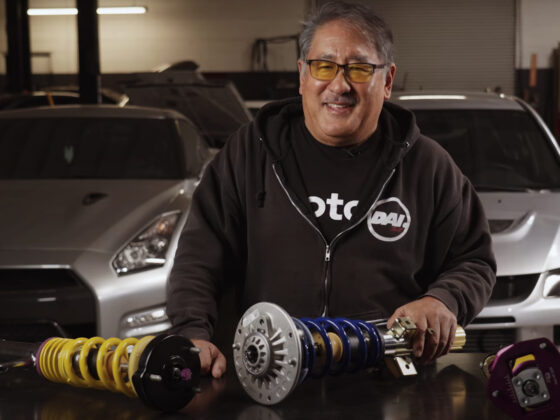
In our first article of this series, I talked about the very basics of shock adjustment in general, basic shock damping technology, and how to adjust single adjustable shocks. For this article to make sense, please back up and follow this link to the first article and read it before reading this one! It probably would not hurt to read the series Ultimate Suspension Set-Up Guide as well.
Watching this video would be very helpful as well.
I would like to thank KW Suspension and ST Suspension for providing me with display shocks for visual aids and providing charts of shock-damping force data.

Most of the commonly available quality single adjustable shocks on the market have most of the adjustment on the low-speed rebound part of the rebound damping curve. Here is a graph of a typical quality single adjustable shock showing the damping force available throughout the adjustment range. In this case, the shock is a KW V2.
Now when we talk about adjusting double adjustable shocks, there is adjustable rebound damping as shown in the chart above with the addition of adjustable compression damping. Having double damping adjustment like this is a great assist giving you a tremendous ability to fine-tune your ride and to get your car to behave in the way that you want it to act.

On the other hand, having two knobs to adjust allows you to really mess things up and to adjust yourself into handling hell if you do things wrong. I will show you a technique where it is impossible to screw yourself into a corner where your car just isn’t working.
There are not too many quality shocks on the market that are double adjustable for a reasonable price point. KW and ST Suspension perhaps have the widest range of applications with an application for nearly everything. If this seems like this is a KW commercial, well this is the reason, KW or ST probably has an affordable application for your car.
Other companies that also do are Feals and Fortune Auto. Going up some in price are Ohlins, MCS, Moton, JRZ, AST, Sachs, and Penske. If no one makes an application for your car and you can fabricate, Koni has the 8611 universal application and Ohllins has a line of universal dampers and easy-to-modify housings. There are also companies like AFCO and JRi but I don’t have any experience with them.

So to make more sense of how to adjust your compression damping, please read part one on how to adjust the rebound and what it affects as well as signs off too much and too little rebound as this is going to add to it.




4 comments
Thank you for this and your previous article on adjusting shocks. Very helpful.
“But what about damping coefficient!” I’m waiting for some FSAE-traumatized person to chip in. 😉
No, good guide; a few nuances on a lot of these directions that I’d sort of thought about but not nearly as concretely as you laid it out, thank you for all this.
I hardly ever calculate that. Not even for developing a new application. It’s because 99% of the time I only have partial data to do so and I have to fill in some blanks by guessing. I think with experience it’s only minimally useful.
Honestly, makes sense. I feel like there’s far more value in being able to go “OK, the car is misbehaving in this way, what do I do to fix that?” and having a plan for what to do before the next session than in trying to refine some way to have a good guess with zero test data.
I have some spreadsheets where I took a platform I can fill in about all the numbers on (ie: Miata) and kind of back calculated some shock dyno data for setups that work through them to see if I could figure out why, and what their guys were thinking of to get there… but that’s more just an experiment rather than an attempt to have a practical thing.